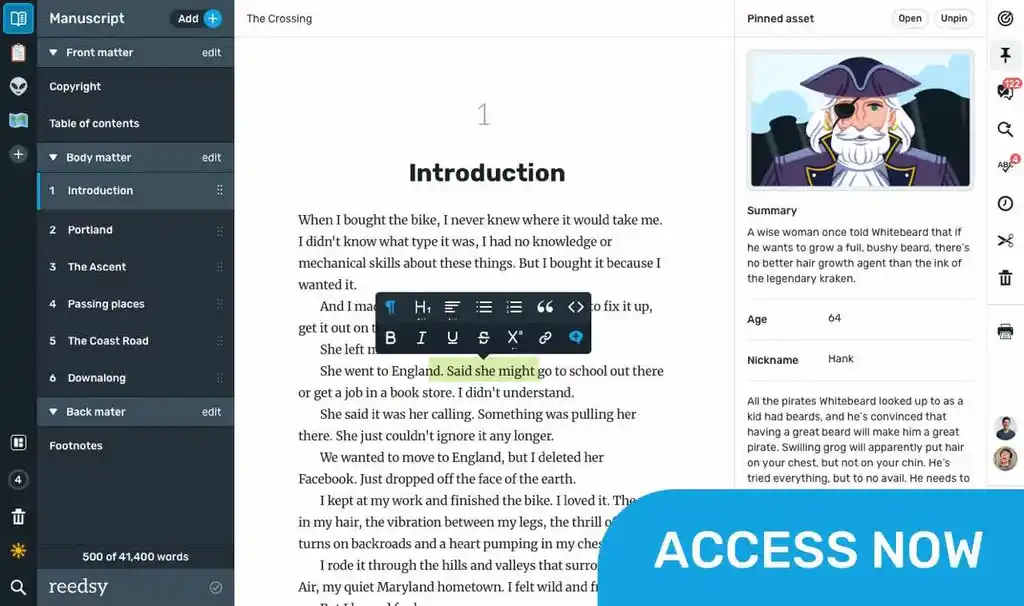As writers, we often lean on dialogue or action to drive our plots, but let’s be honest — some of the juiciest moments in storytelling happen in silence. They unfold inside a character’s head. That’s where internal monologue comes in.
In this article, I’ll share some of my favorite internal monologue examples from literature and show you how authors use this technique to create a direct line to a character's private thoughts, emotions, and desires. Let’s get started!
1. The Shining, Stephen King
Sometimes, we have to hold our tongues to keep ourselves out of trouble, right? That's where struggling writer Jack Torrance finds himself at the opening of The Shining when he's interviewing for a seasonal job as a hotel caretaker — a position he clearly feels is beneath him:
Jack Torrance thought: Officious little prick.
Ullman stood five-five, and when he moved, it was with the prissy speed that seems to be the exclusive domain of all small plump men.
The horror genre is all about tapping into heightened, raw emotions. King uses Jack’s indirect internal monologue to do just that, bringing the reader closer to his psychological state from the get-go. By slipping into this passage of internal thought, King instantly lets us peer into Jack's mind without slowing down the present action.
First, we see an indirect internal monologue, which reports Jack’s thoughts in third person — “Jack Torrence thought.” Then, we see a snippet of direct internal monologue — “Officious little prick” — where Jack’s unfiltered thoughts burst onto the page in first person, free from any external narration.
This brief aside indicates everything that follows is indirectly Jack's thoughts — a signpost that prevents readers from getting lost on the opening line of the novel.
Through this combination of monologue, we gain a sense of Jack’s voice and personality — namely, his distaste for authority and his barely controlled anger, which readers will later discover to be key parts of his identity. If Stephen King had simply told us, “Jack felt angry at Ullman,” we would miss out on crucial character information right off the bat! Inner monologues are therefore an efficient way to show readers who your character is, without having to spoon-feed them with backstory.
⭐ Pro-tip: In scenes with multiple characters or lines of dialogue, don’t be afraid to use thought tags like “he thought” or “she wondered” to avoid confusion.
2. A Little Life, Hanya Yanagihara
Jude, the protagonist of A Little Life, is a deeply scarred character whose fragile sense of self-worth has been shaped by a childhood marked by abandonment and trauma. In adulthood, when his father figure Harold offers to adopt him, Jude is torn between a longing for love and acceptance and his deep-rooted belief that he doesn't deserve either — sparking a painful inner conflict:
“I wanted to talk to you about something, but – I don’t know where to begin.” Stupid, he told himself. This is such a stupid idea. You were so stupid to think any of this could ever happen. He opened his mouth to continue and then shut it, and then opened it again: he was a fish, dumbly blowing bubbles, and he wished he had never come, had never begun speaking.
Here, Yanagihara directly contrasts Jude’s dialogue with an italicized direct internal monologue that reveals his negative, intrusive thoughts. Most of the characters he deals with are unaware of his trauma, so Jude's internal monologues are the only way to let readers know the true depth of his inner turmoil, building dramatic irony that makes Jude’s story all the more tragic.
You might try a similar technique in your own story to reveal a character’s inner conflict, like Jude, or even to create tension by highlighting miscommunication between characters.
3. Book Lovers, Emily Henry
Speaking of miscommunication, romance novels often revolve around misunderstandings: she loves him, but he thinks she hates him. They’re sworn enemies, but soon they discover that they share the same passion for dogs (or whatever). To show your characters’ mistaken beliefs and prejudices, internal monologue can be a powerful tool — as seen in Emily Henry’s bestselling novel, Book Lovers.
Nora is a sharp-tongued, big-city literary agent. Charlie is an editor with whom she’s had a rocky professional history. When they cross paths again while Nora is on vacation, old tensions resurface — especially in scenes like this:
An irritable laugh lurches out of me. “Fine. It’s not your cup of tea. But maybe it would be helpful,” I fume, “if you told me what you liked about the book. Then I know what to send you in the future.” Liar, my brain says. You’re not sending him more books. Liar, Charlie’s unsettling, owlish eyes say. You’re not sending me more books.
In just a few lines, we get layers of tension:
- Nora’s words are clipped as she fights to remain professional. However, her internal monologue betrays her frustration.
- Her thoughts also reveal something deeper. She’s not just annoyed, she’s second-guessing herself and projecting her insecurities onto Charlie.
- She imagines his judgment and invents what he might be thinking, through her own emotional filter.
Because Book Lovers is driven by misunderstandings and slow-burn emotional shifts, Nora's internal monologue becomes essential. It helps us trace the gap between what she says, what she thinks, and how her perception of Charlie evolves — page by page, thought by thought.
This moment shows us how internal monologue doesn’t just fill emotional gaps — it can deepen the reader’s connection with the character by bringing them along for the ride.
⭐ Pro-tip: Inner monologue can be a natural way to offload exposition (like character info or plot) in a way that isn’t through dialogue or flashbacks. The inner monologue in our Book Lovers excerpt serves a dual purpose: it reveals Nora’s first impression of Charlie, and it visually describes him for the reader's benefit.
4. Bunny, Mona Awad
Samantha Mackie is an MFA student who can’t help but feel like an outsider among a cohort of rich, impossibly twee girls who call each other “Bunny” like it’s a secret handshake.
We meet Samantha at the beginning of a new term, where she has an intense encounter with a professor known as “The Lion”. In the previous academic year, Samantha had developed a close relationship with him, but after her cohort started spreading rumors about their connection, “The Lion” distanced himself completely. Here’s a glimpse of Samantha’s reaction:
“Samantha?”
And then what? And then I could just cut to the chase and say, I don’t understand what happened between us exactly, but can it just not be weird anymore? But my fear is that he’ll look at me like I’m insane. Weird? What happened? Between us? Samantha, I’m sorry but I really have no idea what you’re talking about, I’m afraid. And he won’t look afraid at all.
On multiple occasions, Samantha imagines similar conversations in her head, and her direct internal monologue draws the reader into these fantasies, which are often far more intense or exaggerated than reality.
You’re more likely to see direct internal monologues like this in first-person present-tense narratives, such as Book Lovers and Bunny. However, where this technique in Book Lovers highlights the disparity between what Nora says and what she thinks, it is used in Bunny to represent the imagined dialogue between Samantha and other characters.
In this way, internal monologues can highlight a character's particular thought process or mental state. They provide a close-up view of Samantha’s character and gives us a front row seat to her insecurities, helping readers to understand her motivations, sense of isolation, and her struggle with self-perception.
⭐ Pro-tip: Vary your sentence length to reflect your character's mental state. If they find themselves in a tense situation similar to Samantha’s, you might also use short, punchier sentences to reflect their disarray.
5. The Eyes Are The Best Part, Monika Kim
There are times when characters find themselves in horrifying situations — moments where fear prevents them from saying certain thoughts out loud. Then there are occasions when characters themselves are the source of horror, and silence becomes an act of self-preservation that keeps their dark thoughts hidden. This is certainly true for Ji-won in The Eyes Are The Best Part…
After being abandoned by her husband, Ji-won’s mother brings a new boyfriend — an obnoxious and inappropriate foreigner who disrespects their Korean culture and hides things from the family. Forced to live with him, Ji-won begins to fantasize about ways to get rid of him — particularly in this moment:
George and my mother are sleeping deeply. Umma is still, but with every breath George hacks and coughs.
I’ll watch as the life seeps out of him. His face will turn blue.
The scene gives me so much pleasure that for a moment I run my hand over the blankets.
Soon.
In early chapters, the narrative is relatively straightforward. But once George enters the picture and Ji-won’s mental state begins to unravel, short, italicized snippets of direct internal monologue start to appear, visually aligned to the right of the page. This is our visual cue that a more primal part of Ji-won’s psyche has taken centre stage.
While the main narrative reveals Ji-won’s situation, it’s these inner monologues that offer a raw, unsettling glimpse into her unfiltered thoughts. This contrast between external narration and inner monologue reveals Ji-won’s inner conflict — a tug-of-war between her Ego and Id — leading to her eventual breakdown and the disturbing events that follow.
6. Gone Girl, Gillian Flynn
If you want to keep your readers guessing, take a cue from Gone Girl, where internal monologue is cleverly used as a red herring to mislead the reader.
This psychological thriller explores the complicated and twisted relationship between Nick and Amy Dunne. Our first excerpt comes from Amy’s diary at the beginning of the novel:
I am fat with love! Husky with ardor! Morbidly obese with devotion! A happy, busy bumblebee of marital enthusiasm. I positively hum around him, fussing and fixing. I have become a strange thing. I have become a wife.
The second is Amy’s present perspective later in the novel when (spoiler alert!) she reveals that she staged her disappearance:
That’s right, I wanted him back so badly that I was willing to re-create that moment. I was willing to pretend to be someone else again. I remember thinking: We can still find a way to make this work. Faith!
As we see, Amy’s real thoughts are revealed later on in chapters that include her direct internal monologue. These thoughts are stripped of the warmth or charm seen in her diary — which, in hindsight, reads like a pointed parody of the perfect housewife (and a decoy to trick the reader into thinking that her marriage to Nick was perfect). In this way, inner monologues can be used as a tool to mislead the reader, leaving them on the edge of their seats to wonder whether or not they can really trust a character's narration.
⭐ Pro-tip: Consider using metatextual devices like letters or diary entries as a supplement internal monologue: it’s a similarly powerful way to reveal information that your character might not naturally say aloud.
7. The Secret History, Donna Tartt
The Secret History follows a group of elite college students whose obsessions with beauty, intellect, and ancient Greek ideology take over their lives. Eventually, these obsessions take hold of Richard, our narrator, and begin to shape his internal monologue.
When this group (another spoiler alert!) begins committing murders, Richard starts to deeply regret his involvement as several cracks in their “romanticized” life begin to show. In this passage, Richard grapples with tremendous levels of guilt after being involved in the death of his friend, Bunny:
I looked terrible. Nobody else was falling apart; yet here I was, shaking all over and seeing bats like Ray Milland in The Lost Weekend.
A cold draft was blowing in the window. I felt shaky but oddly refreshed. I ran myself a hot bath, throwing in a good handful of Judy’s bath salts, and when I got out and put on my clothes I felt quite myself again.
Nihil sub sole novum, I thought as I walked back down the hall to my room. Any action, in the fullness of time, sinks to nothingness.
It’s fair to assume that most readers won’t catch the Latin reference at first, but through the surrounding context, readers can still understand Richard's thought process. Despite his apparent guilt, he returns to his normal self by recalling this Latin phrase — nothing new under the sun. By romanticizing his actions, he's almost using ancient philosophy as a shield from the brutal reality of what he's done.
Sure, it's concerning that Richard can absolve himself of guilt with just one thought, but the act of talking oneself down is a very human thing to do. Sometimes, a person can change their mind in an instant through a single thought or epiphany.
Where other stories might stretch out this change in opinion or dwell on the psychological toll of guilt, Tartt cuts straight to the chase, delivering Richard’s sequence of thoughts in a raw, immediate form through direct internal monologue.
Here, internal monologue does more than reveal character: it offers deep, psychological insight into how Richard manages to rationalize the unthinkable.
Now that we’ve broken down these bestselling internal monologue examples, you should be well equipped to spot — and craft — compelling internal monologue in your own writing. Don’t be afraid to let your character's inner thoughts steal the show — after all, who knows what kinds of secrets they’re hiding in their heads…










